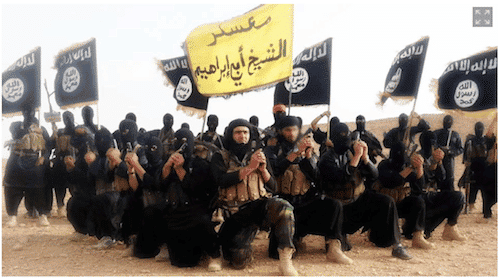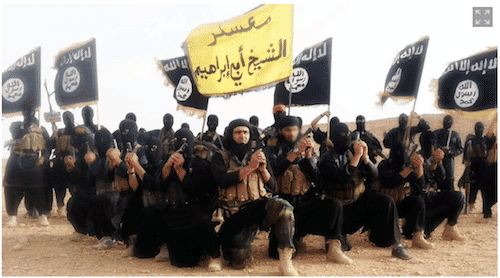
On September 30, a Russian general walked into the US embassy in Baghdad and told US diplomats that Moscow would commence air operations in Syria in “one hour.”
It would be best, he said, if the US stayed out of the way.
The general was affiliated with the newly created Iraqi intelligence cell staffed by Russia, Syria, and Iran. It was both hilarious and intriguing that Moscow gave such short notice and didn’t share any information about who Russia intended to target.
At a base level, it was exceptionally amusing that The Kremlin essentially walked into a US embassy, told the US military to leave the skies above Syria or risk being shot down, and then walked out. But more specifically, the fact that Moscow gave only an hour’s notice and did not provide anything in the way of details seemed to underscore Russia and Iran’s shared suspicions that the US is backing any number of Sunni extremist groups fighting for control of the country. That is, Moscow didn’t want Washington to have the time or the information necessary to warn ISIS or any of the West’s other proxy armies.
In the weeks since Russia began flying combat missions from Latakia, the perception has been that Moscow’s warplanes have been far more effective at targeting extremists than American fighter jets. It is of course impossible to determine if the videos emanating from the Russian Defense Ministry depict what they purport to depict, but by all accounts, this is a far more aggressive campaign than that which the US launched some 13 months ago. It’s also been clear from the location of Russia’s strikes that although shoring up Assad in the west (i.e. securing Syria’s major cities for the regime) was the immediate priority, Moscow has effectively established a no-fly zone over the country and, if you believe Ankara, Russia has even ventured into Turkish airspace a time or two (or three, or four).
Obviously, this threw the Pentagon into disarray. It was no longer clear where the US could fly without risking a dogfight with a Sukhoi, and it was no longer clear who the US could support with airstrikes without pissing off Moscow.
And so, with its bluff thus called, the US simply stood aside and watched as Russia and Iran began to systematically dismantle the opposition funded by Riyadh, Doha, and Ankara.
Or at least that’s how any rational observer would interpret the situation. But there’s nothing rational about Washington when it comes to foreign policy which is why the US is now taking a page out of the economist playbook by swearing that the “lull” in airstrikes against “terrorists” in October had nothing to do with the fact that Russia was bombing the entire country and everything to do with – drumroll – weather. Here’s Reuters (emphasis added):
U.S. and coalition forces are likely to increase air strikes against Islamic State targets in Iraq and Syria in coming weeks after a lull in September and October, the head of U.S. Air Forces Central Command said Saturday.
Lieutenant General Charles Brown told reporters at the Dubai International Air Chiefs Conference that the reduction in air strikes was due to weather and to a slowdown in activity on the ground and not due to the start of Russian air strikes in the region.
And here’s WSJ (emphasis added):
The increase in raids on Islamic State fighters should unfold over the next few weeks, U.S. Air Force Lt. Gen. Charles Brown Jr. told reporters on the sidelines of the biannual Dubai International Air Chiefs Conference on Saturday.
‘There was a little bit of a lull,’ after a busy July and August, he said. Poor weather and a lack of movement of Islamic State forces on the ground hampered the ability to find and attack targets, he said.
If there’s some “residual seasonality” going on here, The Pentagon could always double seasonally adjust the airstrike data.
And make no mistake, this has nothing to do with the Russians. It’s strictly a coincidence that the US airstrikes in Syria stopped once the Russians started flying from Latakia (via WSJ):
The slowdown of U.S. airstrikes coincided with Russia’s deployment of combat jets to Syria and the launching of its own airstrikes. But Lt. Gen Brown said that had ‘nothing to do’ with the U.S. efforts.
Of course not. The terrorists are simply staying indoors these days … after all, the weather is bad:
‘If they’re not out and about, it’s harder to strike.’
Note that the weather wasn’t bad enough to keep the Pentagon from paradropping hundreds of tons of ammo and weapons into the middle of the desert for the probably fictitious “Syrian Arab Coalition.”
So, as long as the skies stay blue over Syria in November, the US will get very “serious” about targeting ISIS and any other Sunni militants that might have designs on blowing up passenger jets over the Sinai Peninsula or burning Jordanian pilots alive or engaging in any other marauding militant shenanigans.
We’ll leave you with the following quote from the Russian Defense Ministry:
‘Twenty-four hours a day UAV’s are monitoring the situation in the ISIS activity areas. All the detected targets are effectively engaged day and night in any weather conditions.’
Reprinted with permission from Zero Hedge.

